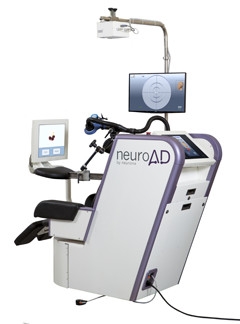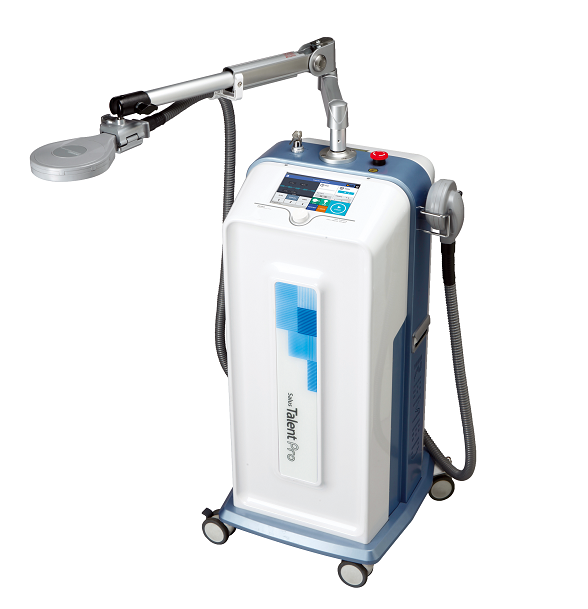rTMS
Repetitive transcranial magnetic stimulation is one of several tools used in the new rapidly evolving field of therapeutic neuromodulation. The brain can be viewed as an electrical organ. Neurons (brain cells) communicate with each other via electrical-chemical signals. Each neuron is physically connected to; ten thousand other cells, on average. Various medical conditions will alter these connections and lead to regional imbalances in the metabolic activity of neurons.
Therapeutic neuromodulation’s goal is to modify the metabolic activity of neurons in certain areas of the brain. It does this by applying small focal electrical currents to specific area of the brain. It can do this through brain implants, applying direct current to the scalp or via an electromagnet such as in repetitive transcranial magnetic stimulation (rTMS). The electromagnet is essentially a large butterfly shaped coil. When a current is passed through the coil a magnetic field is generated. By holding the coil to the scalp and switching the magnetic field on/off it can induce a small focal electrical current in the cortex (superficial layer of the brain). With repetitive stimulation you can induce a long lasting (several months) change in the metabolic activity of the neurons within the area being stimulated.
Depending as to which area of the brain is stimulated rTMS has been found to be beneficial therapeutically in a growing number of medical conditions.
To get in touch
What Do Customers Say?
“I have been fascinated by the incredible responses that we have had from patients. It has done wonders for so many of them. There are a population of patients who just do not respond to antidepressant treatment and this has been an excellent option for them.”
Dr Nikhila Deshpande
Tranquil TMS
“We find that the rTMS is a very well tolerated, pain free treatment that can easily be incorporated into the patient’s day with very little disruption and, of course, most importantly, it works. The treatment is well supported by research as well as anecdotal experience It adds immensely to our services here”
Dr Meetu Sonsati
Oaktree Clinic
“Treatment resistant depression is a devastating condition associated with premature death from suicide or poor physical health and an impaired ability to work. We have had a limited degree of success with talking therapies and antidepressant drugs. Now we have a safe third option.”
Dr Richard Morriss
University of Nottingham
Process
- Bring a list of what you’re taking to your appointment and include dosages and how often you take them.
- You will need to have a non diagnostic MRI of the brain at a private MRI clinic (MRI St-Joseph). This is necessary for us to use our neuronavigation system.
- Transcranial magnetic stimulation isn’t invasive, doesn’t require anesthesia and can be performed in a doctor’s office. You don’t need to arrange for someone to drive you home after treatment.


Side Effects
Transcranial magnetic stimulation often causes minor short-term side effects. These side effects are generally mild and typically improve after the first week or two of treatment. They can include:
- Headache,
- Scalp discomfort at the site of stimulation,
- Tingling, spasms or twitching of facial muscles,
- Dizziness,
- Discomfort from noise during treatment.
Serious side effects are rare, they can include:
- Seizures,
- Mania, particularly in people with bipolar disorder,
- Hearing loss due to inadequate ear protection during treatment.
More research is needed to determine whether transcranial magnetic stimulation used repeatedly over years may have any long-term side effects.
Costs
(The numbers of sessions vary from one individual to the next and for each medical condition treated. On average, for depression, 30 sessions over 6 weeks is recommended and for stroke rehabilitation, 20 combined sessions of rTMS and Neurogym is recommended.)
More About rTMS
rTMS for depression
Major depressive disorder is a common recurrent and frequently chronic disorder. Treatment is often challenging; an estimated 20-40% of people affected with depression do not benefit sufficiently from existing medications or psychotherapy. rTMS has been proposed as viable treatment alternative and has been approved as such by the FDA in the USA since 2005. Studies have shown that in people who have failed one or more antidepressants, 6 weeks of rTMS therapy can reduce depression symptoms by ≥50% in 24-44% of people and induce a remission in 15-36%.
Many explanations have been proposed to explain the range in efficacy between studies. These include:
- Different rTMS treatment protocols.
- Inaccuracy in localizing the DLPC the area of the brain which needs to be stimulated.
- Misalignment of the coil relative to the brain either at treatment initiation or during the treatment.
Clinique Neuro-Outaouais has been using rTMS for several years, always seeking to improve its technique.
We now use a neuronavigation system which eliminates the inaccuracy in site location and possible misalignment of the coil. We have adopted a protocol which stimulates both sides of the brain and has been associated with a higher response rate.
References
**Therapeutic options for treatment-resistant depression, 2012.
rTMS for stroke
Stroke is a major cause of prolonged neurological disability in adults. Fortunately, neuroplasticity and cortical reorganization has been shown to occur after brain damage from a stroke or other disorders. The brain is divided into two halves called right and left hemispheres. These are connected by a structure called the corpus callosum. Normally, there is a balance of function between the two hemispheres which is mediated by interhemispheric inhibition. When a stroke occurs the affected hemisphere can be doubly disabled first by the stroke itself and second by the unchecked inhibitory influence of the intact hemisphere. rTMS in acute or chronic stroke patients can be used to correct the imbalance between the two hemispheres. rTMS can also be used to stimulate the damaged area in order to potentially encourage cortical reorganization. Both approaches have shown added benefit in recovering motor function after a stroke. The duration of such benefits has varied from 3 months to 1 year. Recently, the rTMS therapy benefit has been shown to be more pronounced if the rTMS is “time locked” ie done in conjunction and prior to physiotherapy exercises. In such instances it could be viewed as “primaning” the brain for the subsequent physiotherapy.
Clinique Neuro-Outaouais together with Clinique Neuro-Gym have developed a unique program of combined rTMS followed by Neurogym training for people with stroke related disabilities.
rTMS in stroke patients is however within the medical community still considered experimental.Many questions remain as to how exactly rTMS works in helping stroke patients recover same degree of motor function and these how best to optimize it.
References
**Theta-burst stimulation of the left hemisphere accelerates recovery of hemispatial neglect, 2012.
**Transcranial magnetic stimulation improves fluency in non-fluent aphasia after stroke, 2012.
rTMS for Post-traumatic Stress Disorder
References
rTMS in other medical conditions
rTMS is being studied in a variety of medical and psychiatric conditions, these incluse:
- Multiple sclerosis -for gait improvement and reducing spasticity,
- Chronic neurologic pain,
- Obsessive compulsive disorders,
- Eating disorders,
- Tremors,
- Epilepsy,
- Tourette’s,
- Schizophrenia,
- Bipolar disorders, and
- Tinnitus
The studies in these conditions have so far been small. Results have varied. Clinique Neuro-Outaouais does not presently offer TMS therapy for these conditions. Depending on future research this however may change.
Find more information on TMS in this report from Radio Canada.





